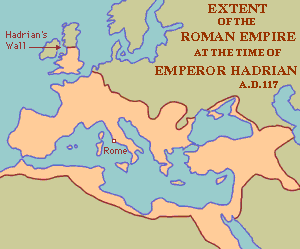 Back to the Picts and Their Legacy Back to the Picts and Their Legacyor Back to Maps Page |
| One of the greatest monuments to the power - and limitations - of the Roman Empire, Hadrian's Wall ran for 73.5 miles (118.3 km) across open country. Why was it built?
At the time of Julius Ceasar's first small invasion of the south coast of Britain in 55 BC, the British Isles, like much of mainland Europe was inhabited by many Celtic tribes loosely united by a similar language and culture but nevertheless each distinct. He returned the next year and encountered the 4000 war chariots of the Catevellauni in a land "protected by forests and marshes, and filled with a great number of men and cattle." He defeated the Catevellauni and then withdrew, though not before establishing treaties and alliances. Thus began the Roman occupation of Britain.
By the time Hadrian became Emperor in AD 117 the Roman Empire had ceased to expand. Hadrian was concerned with consolidating his boundaries. He visited Britain in AD 122, and ordered a wall to be built between the Solway Firth in the West and the River Tyne in the east "to separate Romans from Barbarians". The Emperor Hadrian built this wall to keep the tribes of the Picts and Scots from invading Roman Britain. It would not keep individuals out, but it would keep an army from invading -- with its necessary wagons for supplies and horses. It also illustrates the end of Roman expansion. By building this wall (from sea to sea), the Romans admitted that they could neither deal with the tribes in Scotland by means of diplomacy or coercion. In the 2nd century A.D. the Roman Empire would cease its growth, which began some 700 years earlier. |
 Nearly 100 years later, in AD 43, the Emperor Claudius sent Aulus Plautius and about 24,000 soldiers to Britain, this time to establish control under a military presence. Although subjugation of southern Britain proceeded fairly smoothly by a combination of military might and clever diplomacy, and by AD 79 what is now England and Wales were firmly under control, the far North remained a problem. However, the Emperor Vespasian decided that what is now Scotland should also be incorporated into the Roman Empire. Under his instructions the governor of Britian, Julius Agricola, subdued the Southern Scottish tribal clans, the Selgovae, Novantae and Votadini by AD 81. Further to the North lived loose associations of clans known collectively as the Caledonians. Agricola tried to provoke them into battle by marching an army into the Highlands eventually forcing a battle with the Caledonian leader Calgacus in present day Aberdeenshire at a place called Mons Graupius. Nearly 30,000 Caledonians were killed, but the Roman victory was a hollow one, for the next day the surviving clansmen melted away into the hills, and were to remain fiercely resistant and independent.
Nearly 100 years later, in AD 43, the Emperor Claudius sent Aulus Plautius and about 24,000 soldiers to Britain, this time to establish control under a military presence. Although subjugation of southern Britain proceeded fairly smoothly by a combination of military might and clever diplomacy, and by AD 79 what is now England and Wales were firmly under control, the far North remained a problem. However, the Emperor Vespasian decided that what is now Scotland should also be incorporated into the Roman Empire. Under his instructions the governor of Britian, Julius Agricola, subdued the Southern Scottish tribal clans, the Selgovae, Novantae and Votadini by AD 81. Further to the North lived loose associations of clans known collectively as the Caledonians. Agricola tried to provoke them into battle by marching an army into the Highlands eventually forcing a battle with the Caledonian leader Calgacus in present day Aberdeenshire at a place called Mons Graupius. Nearly 30,000 Caledonians were killed, but the Roman victory was a hollow one, for the next day the surviving clansmen melted away into the hills, and were to remain fiercely resistant and independent.